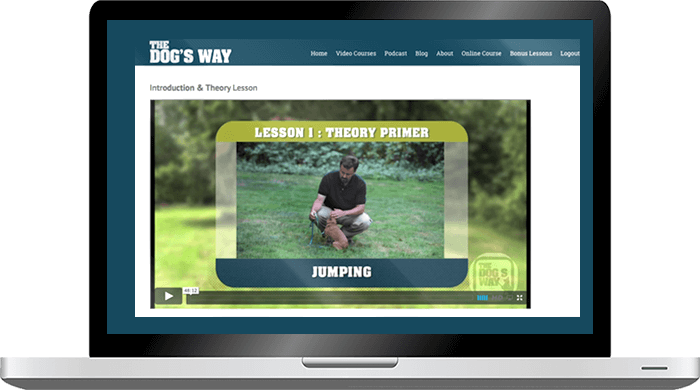Barking Dogs at the Office

I had two really similar cases this week and thought you might want to hear about the resolution to each of them in the event that their situation and solution could help you. These two cases were great practical applications of the three main principles my training is based on: following the natural learning process, getting the “freedom/responsibility quotient” in balance, and teaching the skill of recovery.
THE SITUATIONS
In both cases, these lucky dogs got to go to work with their owners. Both cases also shared a similar complaint by the humans; the dogs would periodically (and in one case nearly constantly) bark at clients that would come through the front door of the office. In my assessment of each case, these weren’t aggression problems per se (though, I imagine, it’s never fun apologizing to your clients when your dog barks at them). I never want to minimize aggressive behavior but both these dogs lacked the follow through that makes ‘alarm barking’ more serious. It’s also worth noting, the tenor of these barks weren’t the “hey, I’m excited someone is here” bark either. Each barking behavior was similar; an alarm bark (an announcement that there was an intruder) BUT without the follow up. Meaning they exhibited none of the signs that they intended to escalate (e.g. charging, lunging, low head with a stiff neck and a ‘locked in’ stare-down or an escalating low growl). There was some reticence in the body language after barking, and after a while (sometimes 10-15 minutes), if the people “behaved” (to the dog’s satisfaction) the dogs would each settle down and ignore the “intruders”. In both cases, the dogs were off leash and able to roam where ever they’d like in the office. These were both adult dogs (over two years old) and were breeds that didn’t have a profile that suggested a high level of protective drive.
THE SOLUTION
THE BASICS AND INDIRECT STUFF: I asked each of the people to remove their dog from the office for a three or four days so they could do some basic foundational work with them. Those of you that have listened to the podcast, or have gone through the video course, know those basics. They worked on: loose leash walking (relationship work), coaching of nervous system recovery (basic core skills), and the owners introduced some basic structure and restriction of some their dog’s usual freedoms around the house.
THE OFFICE STUFF: Once they brought their dogs back to the office, we introduced some new policies. As opposed to letting the dogs roam around the office off leash, I asked each owner to set their dog’s bed next to their desk with a leash cinched around the leg of their desk to limit the dog’s freedom. This was done in part because, in both scenarios, the owner’s desks were about as far from the entry door as you could get. In situations like these, we want to start easy, create some structure, and create some distance from any triggers. Those of you familiar with the podcast and video lessons know that this is the step of bringing what I call the “freedom/responsibility quotient” back into balance. (If that doesn’t make sense you can download the free eBook on the topic on the home page of the website www.thedogsway.com)
THE INTERACTION WITH THE DOGS IN THE OFFICE SITUATION
So, after this foundational work and office structure was set up, we were ready to deal with the entry of people into the office directly.
The negative feedback: (yes, I believe in communicating to our dogs that they have done something wrong when they do …
We set this scenario up with “fake” clients a few times first. This “interruption and correction” procedure had to be repeated a couple of times in each of the first few trials of these ‘set ups’. That is to say, in the first several corrections, once the dog settled and the owner walked away from the dog, their dog let out a mitigated little bark towards the intruders again. As soon as that happened, the owner spun around, sprayed the air sprayer, said quiet, and punctuated the whole move with the tug up on the leash with a finishing “quiet!”
The Positive Feedback: After two or three “set ups” of the above described scenario, (giving feedback to the dogs, that barking when people came into the office just wasn’t cool), we began seeing attentive body language and a “checking in” with the owner when “fake clients” would come in (and in one case when real clients unexpectedly came in). The moment the owners saw the “recovery” in their dog’s nervous system (That is, unlocking visually from the clients with a general relaxation in the dog’s body, ground sniffing (as if to investigate), and ‘checking back in’ with the owner visually) they verbally marked the recovery body language with a marker word of praise – “good!” Then they (to use Skinner’s term) reinforced. With one dog it was a good slow 10 second rub down and praise, with the other dog we found that a short pet and then (once the dog was completely recovered) giving a Kong with a dab of peanut butter and with a couple pieces of kibble stuck inside was helpful to reinforce what we verbally marked and socially praised with petting. (NOTE: this giving of a chew toy or food is to reward complete recovery, and then occupy the dog, and shouldn’t be confused with the “distraction” technique)
THE FEEDBACK
It’s been about a week of this sort of work and the clients say that they are seeing “totally different dogs”. The office staff in each situation have said they’ve noticed “an unbelievable difference”.
THE NEXT STEPS
In office awareness
The progression of the this sort of scenario is to start catching the right behavior all the time and then beginning to relax the restriction of the “tie out” in favor of dragging the leash around the office and still maintaining some semi-restriction in the dog’s movement while at work.
Improvement of the basic training
In the basic work outside of the scenario, the clients are teaching their dogs functional obedience like a reliable: sit, down, “go to your bed”, and temporary boundaries ( that is, a command that creates an invisible boundary that your dog cannot cross but gives them the freedom to do what they want on the other side of that line). As the dogs become more functional in their practical obedience skill, the owners can begin to choose what sorts of commands they will use to manage their dog while in the office.
Progress to actually meeting people
In the next couple weeks, we will begin brining the dogs on leash up to the front door to be near the clients and coach them through recovery in closer proximity to the “triggers” that once caused the unwanted barking. If the owners want to, we’ll go through the process of re-doing the meeting ritual and have the dogs actually meet the clients politely.
CAVEAT
As always, if you have a barking/potential aggression issue, get your dog assessed in person and be prudent in dealing with scenarios like that.
Hopefully, some of these ideas helps you with your situations.
Feel free to email or call into the Podcast call in line with questions or comments.
All the best,
Sean

About the Author: Sean
I’ve been training people and dogs in Seattle for the last decade and a half. My main focus when working with clients every week in one-on-one, private lessons is to help people learn to get their dogs to a functional level so that they can actually enjoy spending time every day with their dog instead of stressing about their dog’s behavior issues.
One Comment
Leave A Comment
Affiliate Program
Make money by referring people to the video course!
. . . . .

About Sean
I’ve been training people and dogs in Seattle for the last decade and a half. My main focus when working with clients every week in one-on-one, private lessons is to help people learn to get their dogs to a functional level so that they can actually enjoy spending time every day with their dog instead of stressing about their dog’s behavior issues.
Ask Sean a question!
If we use your question in the show, Sean will send you a coupon code for free access to the online video course!
If you have a question you’d like me to respond to on the show (and you want to hear yourself on a future episode) leave me a voice mail! 1 (844) 364-7929 or email me here.


This is great. I have a rescue who came from a very volatile background. She was left outside for three weeks during the double snow-storm the PNW had last year (2019, January-February.) Her owners abandoned her, never to return. She was 6-7 pounds underweight, had “missing” pads from her feet due to the snow and cold, and clung to me the moment she was in my arms. Friends of ours saw her, rescued her and she’s been with us ever since. Leia is so sweet, cuddly, and overall a very quiet and lovable dog. However, she is terrified of men. She has warmed up to my husband, and she’s okay around men if i’m present. Leia is around 2-3 years old now, and she is a ChiPinPomPoo. We did a DNA test on her, lol. She is about 10 pounds, very blonde, and beautiful. She is my office dog, as well. But now, the last week, she has began to bark every time the door opens coming into our shared office.She responds very well to me, and stops when told, but it’s becoming disruptive. I am assuming she has settled in and gotten comfortable, and so is now protecting, but yet it doesn’t feel comfortable. Leia (sometimes called LaLa) is not our first rescue, and it took a minimum of two years for our other rescue who was also violently treated, to fully come around and is doing amazingly now! Mia will be ours for for four years this July. Leia just celebrated her one year with us and we couldn’t possibly love her more!